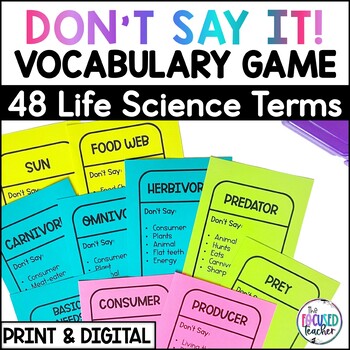5th Grade Living and Nonliving Things in Ecosystems Science Review Game
- Zip
- Google Apps™

What educators are saying
Also included in
- This bundle includes an ENGAGING, INTERACTIVE SCIENCE VOCABULARY GAME that your fifth-grade students will love to play! Similar to a popular family game, your students will describe 160 physical, earth, space, and life science mystery terms without saying five correlating words. Fifth-grade sciencPrice $10.80Original Price $12.00Save $1.20
Description
Looking to engage your fifth-grade science students in a fun vocabulary review of living and nonliving things in an ecosystem? This low-prep science game encourages students to think on their feet and form deeper connections to 48 life science vocabulary words associated with ecosystems, food chains and webs, adaptations, traits, and life cycles. This game is so entertaining even your most reluctant students will excitedly jump in and play!
How it works: Similar to a popular family game, a player draws a game card and describes the “mystery” science vocabulary word at the top to his/her team without saying five “forbidden” words.
The five “forbidden” words are terms that fifth-grade science teachers most often use when introducing life science vocabulary to their students. Not allowing students to use the words they usually hear in class forces students to think differently about the academic vocabulary and look for related words, thus forming deeper brain connections.
Isn’t that what vocabulary practice should promote, a deeper, not superficial understanding? Fifth-grade STAAR question writers sure expect students to apply science vocabulary in many different contexts!
✔️✔️ Check out the PREVIEW to see a list of the vocabulary terms and the preview video to see all the parts of this game! ✔️✔️
THIS PRODUCT INCLUDES ~
PRINTABLE COLOR & B/W GAME:
- 48 vocabulary cards & student game instructions
- Editable Microsoft PowerPoint® & Google SlidesTM presentations - Use this to create your own vocabulary cards or modify the game instructions.
- Share the presentations with accelerated students so they can create game cards too!
DIGITAL GAME:
- A Microsoft PowerPoint® & Google SlidesTM presentation with each game card on a single slide
- Small Group Play: Share a copy of the game with your students in your LMS
- Whole Class Play: Display a slide on your classroom interactive whiteboard. A team’s Guesser stands in front of the class with his/her back to the board. The Guesser’s team has a certain amount of time to provide clues about the mystery word. If the Guesser correctly guesses the word before time is up, that team earns a point. Then the next team sends up their Guesser for the new mystery word.
- There’s also a separate digital version specifically for teaching students online
GOOGLE JAMBOARD SCOREBOARD:
- Use to keep track of team points
- Perfect for any competitive classroom game!
Want a year's worth of fifth-grade TEKS-aligned Don’t Say It Vocabulary Games? Check out the bundle and save 20%!
___________________________________
Related life science vocabulary products:
___________________________________
If you have any questions about this resource, please leave me a message on my Q&A page. I will respond ASAP!
Thank you for visiting my store!
❤️ The Focused Teacher
Customer Tips:
How to get TPT credit to use on future purchases:
Go to your My Purchases page. Beside each purchase, you’ll see a Provide Feedback button. Click the button to go to a page where you can give a quick rating and leave a short comment on the product. Every time you give feedback, you earn TPT credits to purchase other products. These credits are just like cash! So please leave a feedback review. I would greatly appreciate it! :)
I ❤️ Followers!
Be the first to know about my store discounts, freebies, and product launches! Look for the green “Follow Me” star next to my store logo and click it to become a follower. You will now receive email updates about this store. :)






